‘Why are you scratching?’ Most dog owners have found themselves asking this question as their dog continues to scratch, day and night. You’ve combed them for fleas, maybe switched to organic shampoo, and still don’t understand why they’re itching until little red dots start to cover their belly. While most people would assume the bumps are from something as simple as fleas, they could be from something much more severe – Pyoderma.
What is Pyoderma?
Pyoderma is a skin infection caused by bacteria or fungus. ‘Pyo’ implies the presence of pus, although it may not be apparent when looking at the skin.
Pyoderma in dogs is a serious skin infection caused by bacteria or fungus that can show up suddenly, with symptoms ranging from minor itching to a large, oozing, painful wound. While Pyoderma usually has symptoms most dog owners would notice, they can easily be mistaken for other infections or skin conditions. Because of this, a swift and proper diagnosis could be the difference between life and death for your precious pup. If you think your dog might have Pyoderma, the best thing you can do is get a quick and accurate diagnosis from your vet as soon as you notice symptoms.
Pyoderma in dogs occurs when a typically healthy colony of bacteria and yeast that live on the skin overgrows and the skin barrier is compromised. This overgrowth of flora is common in several conditions that make a dog at risk for contracting the infection such as: allergies, parasites, insect bites (fleas, ticks, mites), injured or moist skin. Pyoderma in dogs can be more common with certain breeds that have folds of skin such as bulldogs, pugs, basset hounds, and mastiffs, as their skin to skin folds creates an ideal environment for bacteria and yeast to grow.
For dogs that do not have these risk factors, Pyoderma can still develop after an injury where the skin is penetrated by something that introduces a new type of bacteria to the dog’s immune system. This could be something as minor as a scratch from bushes or a bite from an unfriendly dog.
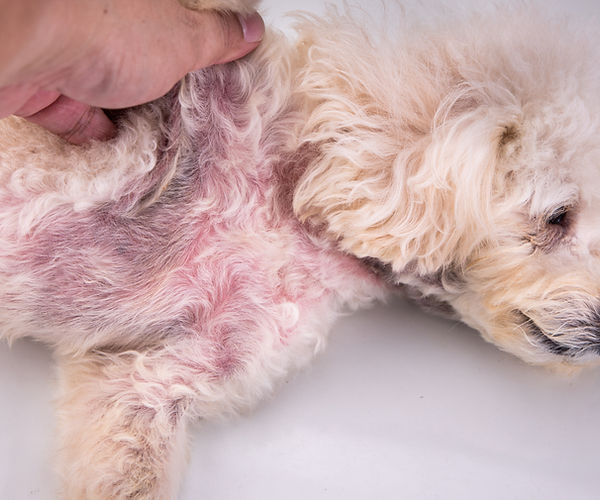
Pyoderma on a dog’s chest.
While Pyoderma in dogs can occur from something unnoticeable, the consequences of not treating the infection can be fatal. In some cases where Pyoderma is not caught and treated soon enough, bacteria can spread from the infected area into the bloodstream and colonize internal organs, which is often fatal. Preventing this outcome should be every dog owner’s goal when an infection or skin condition crops up, but what exactly should you look for?
Symptoms of Pyoderma in Dogs
Symptoms of Pyoderma in dogs are hard not to notice when the infection is severe, but it can often start with just minor itching, biting or scratching. A ‘hot spot’ can develop in just hours upon initial infection and it is important that dog owners watch closely for symptoms. Here are the most common symptoms associated with Pyoderma.
Pyoderma Symptoms Include:
- Rash
- Pustules or bumps
- Fever
- Redness
- Hair loss or bald spots from excessive scratching
- Odor
- Oozing
- Scabbing or scaling
- Itching
What Does Pyoderma in Dogs Look Like?
Dog Skin Rash and Dog Pyoderma Photos:
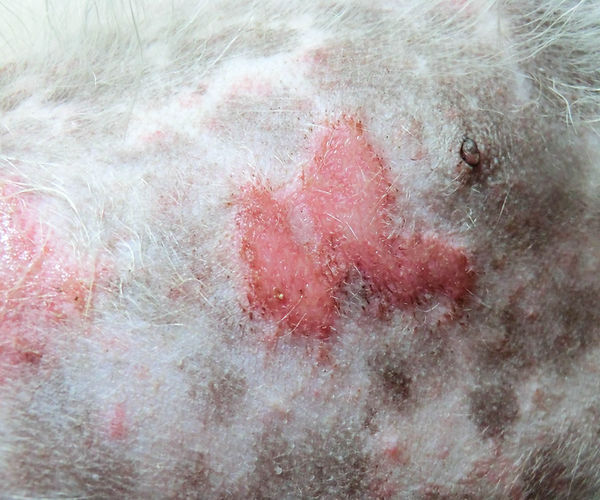
Pyoderma in dogs, a close up of the skin.
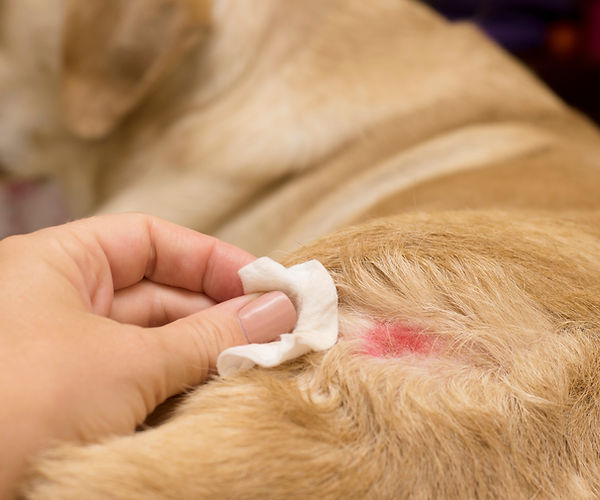
Pyoderma on a lab.
Holistic Treatment for Pyoderma In Dogs
Many dog owners are dedicated to giving their pups the most natural and holistic products available, and in general, this can help keep unnecessary or harmful chemicals away from your dog. However, there comes a point when holistic treatment options for medical conditions, like Pyoderma, not only can’t help but can make matters much worse. Some holistic treatment options suggested on the internet can actually make the infection more painful for your dog, and make the infection spread much faster. A popular home remedy for Pyoderma and many other skin conditions is coconut oil. Even though you may put coconut oil on your own skin, rashes or skin conditions, that does not make it a safe alternative for your dog if they could have Pyoderma. Oils like coconut oil create damp conditions which help yeast and bacteria thrive and spread more rapidly.
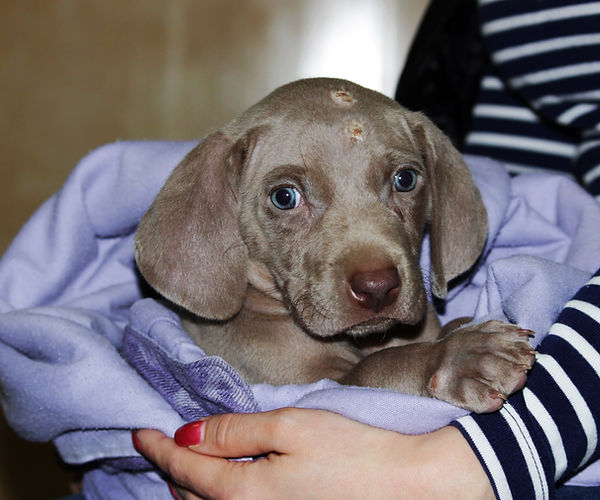
Pyoderma on a puppy’s head.
One of the biggest problems with trying to treat Pyoderma in dogs holistically or at home without the direct guidance of a vet, is while owners wait to see if holistic options work, the infection can rapidly get worse and harder to treat. While it is admirable to opt for natural products and holistic treatments for other conditions or problems in dogs, Pyoderma needs to be treated by a licensed veterinarian.
How to Treat Pyoderma in Dogs
The best treatment for Pyoderma is done by a veterinarian once a diagnosis is reached. Dogs will often be prescribed oral antibiotics, antifungals, or both, depending on the severity of the infection. Medicated shampoos, creams, sprays or wipes may also be prescribed, but should not be used without the direction of a vet, as overuse or unprescribed use of topical treatments can contribute to antibiotic resistance. Never use old prescriptions for a new infection, as this could contribute to antibiotic resistance and be the wrong antibiotic for the current infection.
When to Take Your Dog to the Vet for Pyoderma
While most dog owners want to avoid a pricy vet bill, by avoiding the vet and prolonging the infection, more drastic treatments and costs will likely be involved. The best way to know when to take your dog to the vet for pyoderma is when you notice uncharacteristic behaviors or scratching, in addition to any of the symptoms listed above. Even if you think it could be allergies, there is no way to make a correct diagnosis without taking your dog to the vet.
Tips for Treating Pyoderma in Dogs
The most important thing to ensure when your dog has a skin infection like Pyoderma is that the infection is treated properly the first time, which requires a correct diagnosis. If your vet uses outdated methods to test for Pyoderma, like culturing methods, it could mean prolonged suffering for your dog, in addition to multiple vet visits and courses of treatment.
Pyoderma Treatments
Veterinarian treatment is recommended to ensure successful treatment and not prolong the infection.
- Antibiotics
- Antifungals
- Shampoos
- Creams
- Sprays
- Wipes
Inaccurate or outdated methods of testing for Pyoderma could prompt treatment with an antibiotic or antifungal medication that will not cure the infection. This quickly contributes to increased antibiotic resistance and makes it less likely that the medication will be able to treat future infections in your dog where it could be the only available option.
Ensuring your vet uses the best test for detecting Pyoderma is critical to the recovery of your dog and also for saving money on multiple trips to the vet. Your vet should use a microbial test that is backed by Next-Gen DNA sequencing, and that also tells them what medications should be used to best treat the infection. Traditional culturing tests can miss up to 99% of all organisms that cannot be cultured in a lab, leading to inaccurate analysis.
A new and accurate microbial canine test that has recently become available is MiDOG. MiDOG is a fast and painless swab test that uses millions of DNA sequences derived from all microorganisms present in a sample to determine exactly what the infection is and how it should be treated. This simple test saves stress and prolonged suffering of your dog and also is the most cost-effective option for dog owners as it reduces the likelihood of unsuccessful treatments and multiple vet visits.
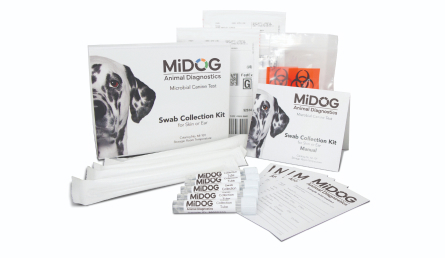
The MiDOG Microbial Canine Test
The MiDOG microbiome test is a microbial identification test grounded on scientific research that provides veterinarians DNA evidence for the guided treatment of canine microbial infections. A MiDOG microbiome test provides the technologies for the accurate identification of all microorganisms within a pet’s sample, independent of culturing.
Find out if your vet uses MiDOG before you book your next appointment!
Categories: Antibiotic Resistance, Bacterial Infections, Dogs, Fungal Infections, Next-Gen DNA Sequencing Technology, Pet Health, Safety and Wellness, Pet Parents, Skin Health, Veterinary Dermatology

